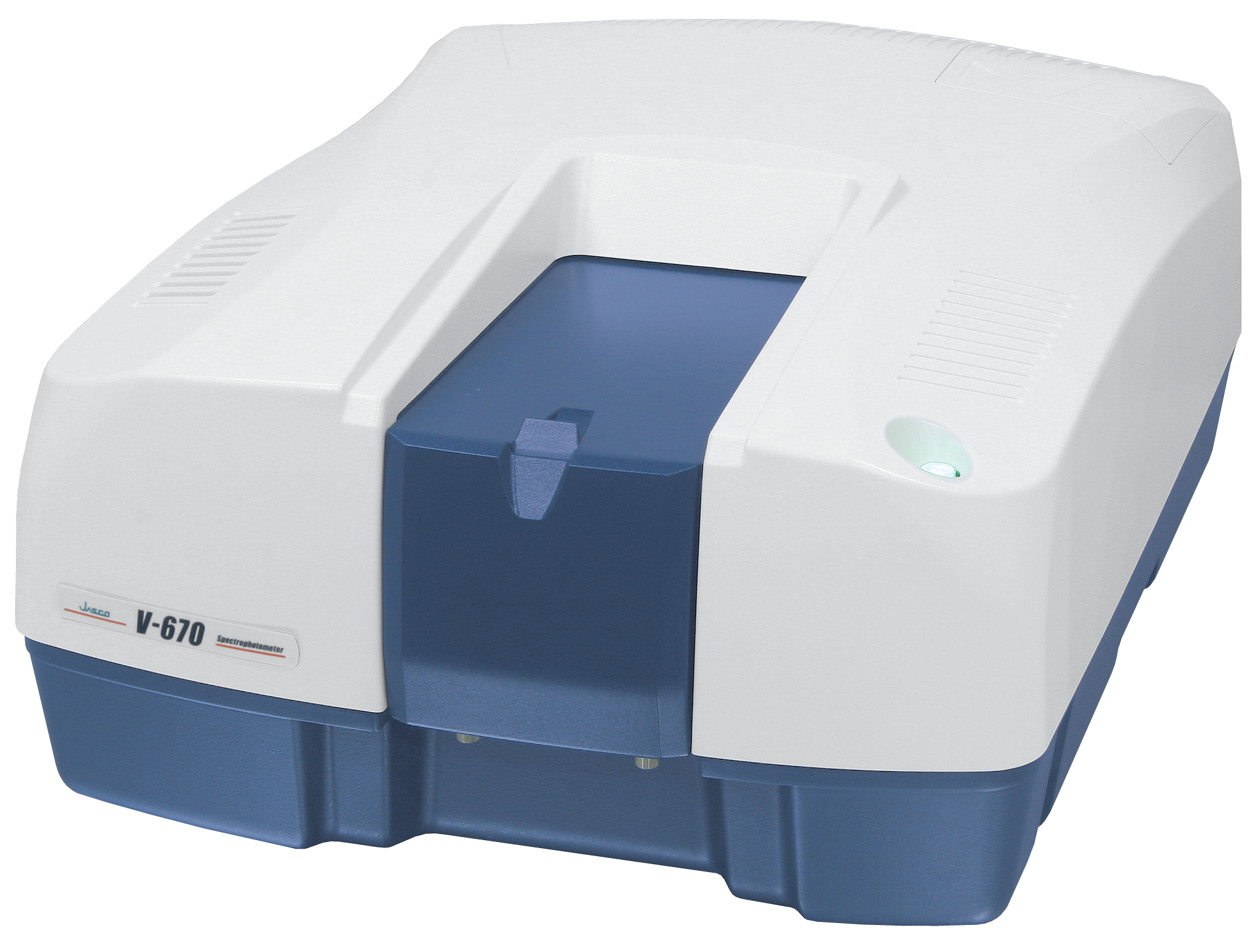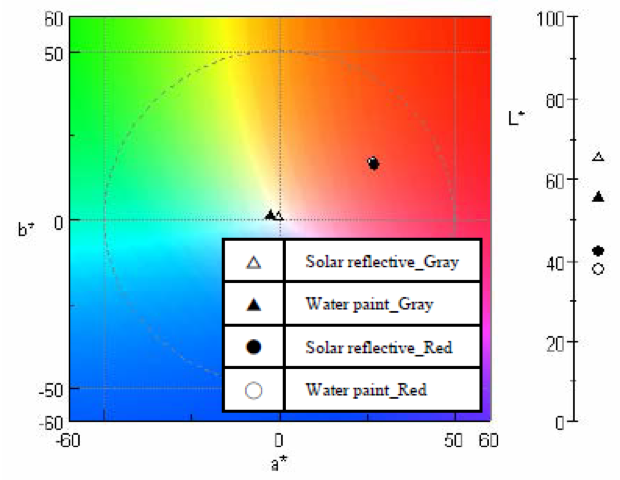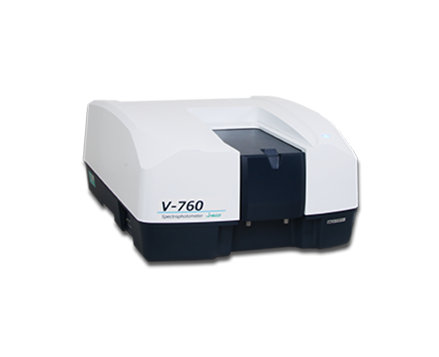Evaluation of Solar Reflective Paint by UV-Visible/NIR Spectrosopy
August 15, 2022
Introduction

In recent years, solar reflective paints have attracted attention as a way to combat the ‘heat island’ phenomenon and as a sustainable household building material. Heat islands are urban areas where the temperature is significantly hotter than the surrounding rural areas and occur where buildings, roads, and infrastructure have replaced a majority of the natural landscape and vegetation.
As shown in Figure 1, solar radiation has significant energy in the near IR region. Solar reflective paints are specifically designed to reflect NIR light with higher efficiency than general usage paints. Therefore, these materials can be used to reflect the heat from the surface of a building, reducing the thermal energy, and cooling the coated object.

This application note evaluates solar reflective paints using a V-670 UV-Visible/NIR spectrophotometer with integrating sphere.
Experimental
Two aluminum plates were painted with both a general water-based paint and a solar reflective paint in two different colors and dried completely for 7 days.

| Measurement Conditions | |||
| Measurement Range | 300-2500 nm | Data Interval | 1 nm |
| UV-Vis Bandwidth | 4.0 nm | NIR Bandwidth | 2.0 nm |
| Scan Speed | 1000 nm/min | Response | Fast |
Keywords
V-670 uv-visible/nir spectrophotometer, UV-Visible/NIR, Materials, Near-infrared, ISN-723 Integrating sphere, VWCD-790 Color diagnosis, VWST-774 Solar/visible light measurement
Results
The diffuse reflectance of the four samples was measured and the spectra are shown in Figure 3. The data illustrate that samples with the solar reflective material paint have higher reflectance in the NIR region than the general water-based paint.

Using the diffuse reflectance spectra, the color analysis of both paint materials was performed with the Color Analysis Program and the results are shown in Figure 4. The data illustrate very similar color positions for both the different grey and red paint samples on the chromaticity diagram, even though the paints have very different reflectance characteristics.

The reflectance values of solar light at three different wavelength ranges was also calculated for the paint samples using the Solar/visible light measurement program. The results are shown in Table 1 and indicate that the solar reflective paint material has higher reflectance values in all wavelength regions, as well as the NIR region.
Table 1. Calculated values of reflected solar light.
| Gray | Red | |||
| Solar Reflective | Water Paint | Solar Reflective | Water Paint | |
| UV-Vis | 24.09 | 32.19 | 21.67 | 17.60 |
| NIR | 70.39 | 26.68 | 64.98 | 50.61 |
| UV-Vis/NIR | 44.30 | 29.75 | 40.53 | 31.95 |
Required Products and Software
- V-750/760/770/780 UV-Visible/NIR Spectrophotometers
- ISV-922/ISN-923/901i Integrating Sphere, 60 mm diam.
- VWST-774 Solar/Visible Light Calculation program
- VWCD-760 Color Evaluation-Color Diagnosis program
Featured Products:
-

A high resolution UV-Visible double-beam, double-monochromator spectrophotometer with exceptional stray light and absorbance linearity
V-760 UV-Visible Spectrophotometer
-

Wide range UV-Visible/Near Infrared Spectrophotometer with PbS detector for wavelengths up to 3200nm
V-770 UV-Visible/NIR Spectrophotometer

Evaluation of Solar Reflective Paint by UV-Visible/NIR Spectrosopy
Introduction

In recent years, solar reflective paints have attracted attention as a way to combat the ‘heat island’ phenomenon and as a sustainable household building material. Heat islands are urban areas where the temperature is significantly hotter than the surrounding rural areas and occur where buildings, roads, and infrastructure have replaced a majority of the natural landscape and vegetation.
As shown in Figure 1, solar radiation has significant energy in the near IR region. Solar reflective paints are specifically designed to reflect NIR light with higher efficiency than general usage paints. Therefore, these materials can be used to reflect the heat from the surface of a building, reducing the thermal energy, and cooling the coated object.

This application note evaluates solar reflective paints using a V-670 UV-Visible/NIR spectrophotometer with integrating sphere.
Experimental
Two aluminum plates were painted with both a general water-based paint and a solar reflective paint in two different colors and dried completely for 7 days.

| Measurement Conditions | |||
| Measurement Range | 300-2500 nm | Data Interval | 1 nm |
| UV-Vis Bandwidth | 4.0 nm | NIR Bandwidth | 2.0 nm |
| Scan Speed | 1000 nm/min | Response | Fast |
Keywords
V-670 uv-visible/nir spectrophotometer, UV-Visible/NIR, Materials, Near-infrared, ISN-723 Integrating sphere, VWCD-790 Color diagnosis, VWST-774 Solar/visible light measurement
Results
The diffuse reflectance of the four samples was measured and the spectra are shown in Figure 3. The data illustrate that samples with the solar reflective material paint have higher reflectance in the NIR region than the general water-based paint.

Using the diffuse reflectance spectra, the color analysis of both paint materials was performed with the Color Analysis Program and the results are shown in Figure 4. The data illustrate very similar color positions for both the different grey and red paint samples on the chromaticity diagram, even though the paints have very different reflectance characteristics.

The reflectance values of solar light at three different wavelength ranges was also calculated for the paint samples using the Solar/visible light measurement program. The results are shown in Table 1 and indicate that the solar reflective paint material has higher reflectance values in all wavelength regions, as well as the NIR region.
Table 1. Calculated values of reflected solar light.
| Gray | Red | |||
| Solar Reflective | Water Paint | Solar Reflective | Water Paint | |
| UV-Vis | 24.09 | 32.19 | 21.67 | 17.60 |
| NIR | 70.39 | 26.68 | 64.98 | 50.61 |
| UV-Vis/NIR | 44.30 | 29.75 | 40.53 | 31.95 |
Required Products and Software
- V-750/760/770/780 UV-Visible/NIR Spectrophotometers
- ISV-922/ISN-923/901i Integrating Sphere, 60 mm diam.
- VWST-774 Solar/Visible Light Calculation program
- VWCD-760 Color Evaluation-Color Diagnosis program

 Download This Application
Download This Application